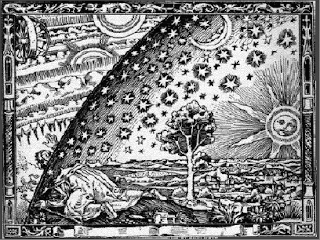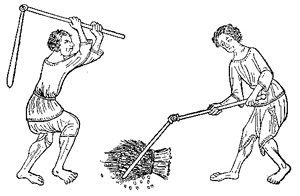 These two terms subjective & objective occur very frequently in discussions of Buddhism. The terms are used in fairly standard ways according to psychological or philosophical norms. But there is also the suggestion that bodhi consists of a breakdown of the distinction between subjective and objective. In this essay I will look at some of the philosophical assumptions behind these two words, and suggest that they are not in fact very useful to us as Buddhists because they don't apply in the domain that most interests us: experience.
These two terms subjective & objective occur very frequently in discussions of Buddhism. The terms are used in fairly standard ways according to psychological or philosophical norms. But there is also the suggestion that bodhi consists of a breakdown of the distinction between subjective and objective. In this essay I will look at some of the philosophical assumptions behind these two words, and suggest that they are not in fact very useful to us as Buddhists because they don't apply in the domain that most interests us: experience.The two words are part of a cluster linked by the common word 'ject' (meaning 'to throw out, to spout') which comes from a Proto-Indo-European root *iē 'to do, throw, project'. The cluster of English words includes: abject, adjacent, adjective, deject, eject, gist, inject, interject, jet, jetsam, jetty, jut, object, project, reject, subject, trajectory.
Etymologically an object is something thrown (ject) against (ob-) i.e. something we come into contact with through our senses (Buddhists also saw objects as striking the senses). While a subject is something thrown under (sub-), meaning something under our control. A 'subject' of the king is subjected to their rules. Similarly we are said (psychologically) to be 'a subject' because we believe our body and thoughts to be under our control. How much this is true is debatable, but this is what the etymology tells us.
Now the suffix -ive is used to turn a verb into an adjective. So objective simply means 'of or pertaining to objects' and subjective means 'of or pertaining to control'. But time has extended the simple meaning. In the case of objective the OED suggests "anything external to the mind, and actually real or existent; exhibiting facts without emotion or opinions; objects which are seen by other observers not just the subject." There are other definitions, but these are the relevant ones. Similarly subjective is now defined in terms of "the personal, proceeding from idiosyncrasy or individuality; not impartial; belonging to the individual consciousness or perception; imaginary, partial or distorted."
So these two terms have come to represent a fundamental dichotomy: what exists in the world, and what I individually perceive, including my sense of being a unique independent self. Along with this dichotomy is the assumption that we can tell the difference between the two domains. A shared experience, for example, is more likely to be considered objective, than a private one. Though we do also doubt the objectivity of groups. It is thought that scientists who describe objects dispassionately are being objective; that they are describing what really exists, as it exists. There are some notable attacks on this view from the 20th century, but the pendulum is already beginning to swing back from the extreme relativity of French nihilism and distrust of authority. Scholars are once again seeking objectivity (scientists never stopped!) though with more caveats than in the past, so that post-modernism was not a complete loss.
Now the Buddhist model of consciousness I have described on a number of occasions, but most recently on my Rave on Phenomena. Early Buddhism grants that there are objects of the senses. It is dualistic to this extent. It grants that there is a sense faculty and that this is associated with a locus of experience (body) and with mental processes such as sensing, apperception, and categorisation. When these come together in the light of sense consciousness then we have an experience. What we are aware of, and respond to is experience: it is the complex product of interactions between sense object, sense faculty and sense consciousness. This is similar to the kind of process outlined in recent years by, for example, Thomas Metzinger. In this model we know nothing of either objects, nor of ourselves as a subject. What we know is the experience of objects and the experience of ourselves as a subject. This distinction is vitally important to get clear.
Shared and repeatable experience leaves us with only one sensible conclusion: objects exist independently of us. There's every reason to think that the early Buddhists agreed with this, and that early Buddhism was therefore a form of Transcendental Realism. That the self is simply an object of the mental faculty is more difficult to show, but I have summarised and endorsed Thomas Metzinger's ideas on the first-person perspective. I'm convinced largely because of what happens when the first-person perspective breaks down. The self is a dynamic process of self-awareness. Like Metzinger I find Antonio Damasio's accounts of how this might come about quite plausible.
The terms objective and subjective as they are used today seem to make assumptions which, if we accept the Buddhist model of consciousness, we must conclude are false. When we say "objective" we cannot be referring to what exists, because it is implicit in our model that we can say nothing about it except how we experience, and experience contains an irreducible subjective component. Indeed I've challenged people several times now to come up with an unequivocal reference to the Buddha discussing the nature of objects and so far no one has come forward to accept the challenge. The objective world becomes a short hand for what we regularly and repeatedly experience, and what seems to be experienced by other people regularly and repeatedly. And while I do say that it makes sense that these experiences must be based on something independent of the observer, I go no further than that.
The idea of subjectivity also needs to be critiqued. The subjective is said to be private and individual, our sense of being a self and being in control. But if we accept that all experiences are conditioned - i.e. arise in dependence on sense object, faculty and consciousness - then we get into a loop of subject and object. We can't be a subject unless we are simultaneously an object, and vice versa. We've tended to separate so-called "subjective experience" off - and to distrust it as a source of knowledge. But experience arises in the interactions of sense-object, faculty and consciousness. No experience can be subjective or objective, all experience is both at the same time.
One of the most important points we can make is that far from being under our control, neither the mind or the body respond easily to our commands. We have limited control at best: we cannot stop our bodies from becoming ill, ageing and dying for example; there are some reflexes we cannot over-ride; we cannot consciously control our viscera. [1] Similarly with our mind. Thoughts and impulses appear unbidden from no-where. Measurement has shown that our motor cortex becomes active some time before we consciously come to a decision to move a limb, that movements are not actually under our conscious control, despite the persistent illusion that they are. Our mind is more amenable to control perhaps, but only with rigorous training spanning years. And then it is so tightly linked to our bodies that as our body ages and becomes ill our minds are involuntarily affected. So many things affect our moods - weather, diet, exercise, social status - and none of this is under our direct control.
So if the terms subjective and objective do not even apply to the Buddhist model of consciousness, then in what sense can bodhi be said to be a breakdown of the distinction between them? We are fortunate in this respect to have the testimony of Jill Bolte Taylor, a neuroscientist who had a massive temporal lobe stroke that deprived her of language and disrupted her sense of self. She described being unable to distinguish where her body ended, and as a result feeling huge and extended. This is a common sensation for meditators, which even I have experienced. For Taylor it was accompanied by bliss and a sense of profundity. This is obviously a very desirable mode of functioning. She had the classic mystical experience of feeling at one with everything, and that everything was one. But in her case the cause was a massive stroke causing extensive brain damage. There can be no doubt that the stroke changed Taylor's life, and that she has dedicated herself to talking about human potential since her rehabilitation (which took many years). But did she experience bodhi? I don't know, in a way I can't know, but my sense was that despite being a likeable person that her experience had some real limitations. My main worry is that apart from having a massive stroke she did not seem to have insights into the processes which might bring about such as experience. I acknowledge the value she found in the experience, and that it is interesting and inspiring to hear her talk, but I am reluctant to pursue the experience of having a massive stroke.
I've tried to show that subjective and objective cannot have the same meaning in a Buddhist context as they do in either in philosophy or everyday speech; that really, considering the way we use these words, they don't apply. I'm resigned to talking about objects of the senses, but I don't see a role for the term 'subject' at all. I find Metzinger's more descriptive terminology - e.g. sense of self, first-person perspective - less fraught and more useful. We don't have subjectivity or objectivity, we have experiences arising from being equipped with sensory apparatus in a world of objects to be sensed. However sometimes it is safe to conclude that an experience was private: if we have a vision, but no one else in the room sees it, then it is a private experience. In this case the object may very well be an internal object such as a memory.
In the long run early Buddhism seems entirely unconcerned by the nature of objects. The nature of self-awareness gets some attention, but the main thrust of the Buddhist program is to be aware of our responses to sensory experience - of being drawn to, attached to, addicted to and obsessed by pleasure especially. The mainstream of practice seems to be paying attention to what is happening in our field of experience, and monitoring our responses to it.
~~oOo~~
Notes
- Most of us have control over the last part of our gastrointestinal tract, and some people do seem able to gain limited control over their body temperature and heart rate. But I've yet to read of anyone with control over, say, their liver or spleen.



